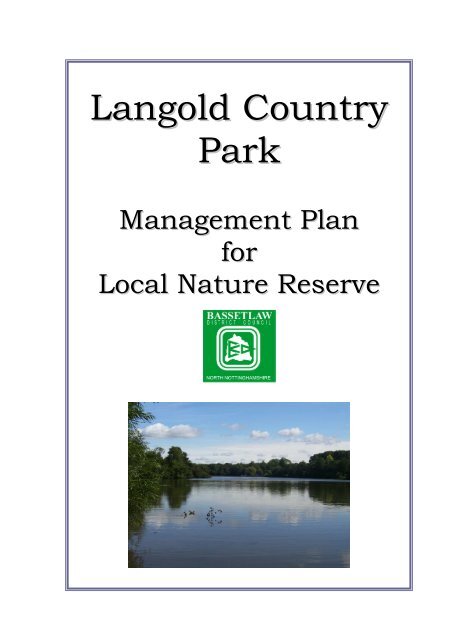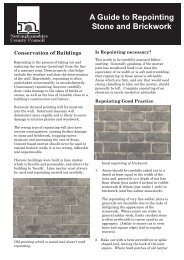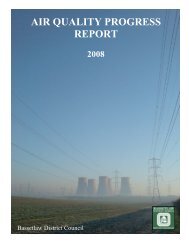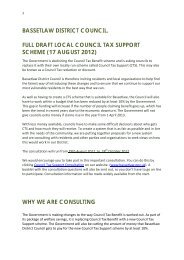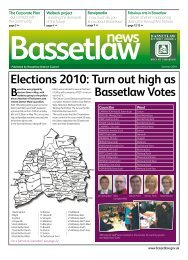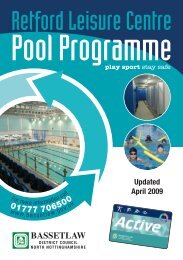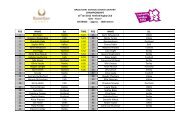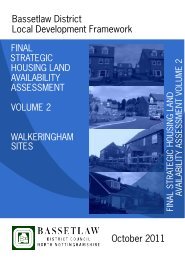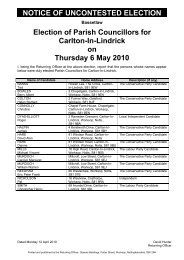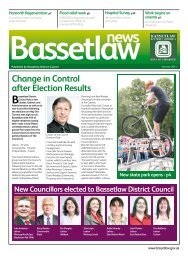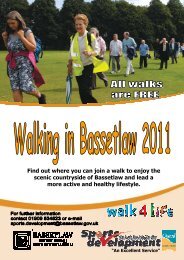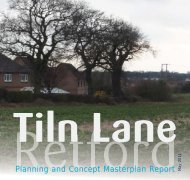Langold Lake Management Plan - Bassetlaw District Council
Langold Lake Management Plan - Bassetlaw District Council
Langold Lake Management Plan - Bassetlaw District Council
Create successful ePaper yourself
Turn your PDF publications into a flip-book with our unique Google optimized e-Paper software.
<strong>Langold</strong> Country<br />
Park<br />
<strong>Management</strong> <strong>Plan</strong><br />
for<br />
Local Nature Reserve
<strong>Langold</strong> Country Park<br />
CONTENTS Page<br />
PART 1: DESCRIPTION<br />
1.1 Location 4<br />
1.2 Map Coverage 4<br />
1.3 Owner 4<br />
1.4 Size 4<br />
1.5 Geology 4<br />
1.6 Aspect, topography and altitude 4<br />
1.7 Access 4<br />
1.8 Surrounding land use 4<br />
1.9 Site Description 5<br />
1.10 Statutory Designations 6<br />
1.11 Non-statutory Designations 8<br />
PART 2: EVALUATION & OBJECTIVES<br />
2.1 Evaluation of site features (Ratcliffe’s criteria) 10<br />
2.1.1 Size 10<br />
2.1.2 Diversity 10<br />
2.1.3 Naturalness 10<br />
2.1.4 Rarity 10<br />
2.1.5 Fragility 11<br />
2.1.6 Typicalness 11<br />
2.1.7 Recorded history 11<br />
2.1.8 Position in an ecological/geographical unit 11<br />
2.1.9 Potential value 11<br />
2.1.10 Intrinsic appeal 11<br />
2.1.11 Biodiversity 12<br />
2.1.12 Identification/confirmation of Important Features 12<br />
2.2 <strong>Management</strong> Objectives 14<br />
2.3 Rationale 15<br />
PART 3: MANAGEMENT DETAILS<br />
3.1 <strong>Management</strong> Projects and Prescriptions 23<br />
3.2 Five Year Work <strong>Plan</strong> 27<br />
3.3 Annual Work <strong>Plan</strong>s 29<br />
PART 4: BIBLIOGRAPHY 34<br />
PART 5: APPENDIX 35<br />
Page 2 of 38
PART 1: DESCRIPTION<br />
1.1 Location<br />
<strong>Langold</strong> Country Park<br />
Grid reference SK 580 865, in <strong>Bassetlaw</strong> <strong>District</strong>, County of Nottinghamshire. The<br />
site lies within Natural England’s Natural Area 23, ‘Southern Magnesian Limestone’.<br />
(A small part of the south western corner of Dyscarr Wood is in South Yorkshire.)<br />
1.2 Map Coverage<br />
Ordnance Survey Landranger map no.120 (1:50 000 scale) and Ordnance Survey<br />
Explorer map no. 279 (1:25 000 scale).<br />
1.3 Owner<br />
1.4 Size<br />
The majority of <strong>Langold</strong> <strong>Lake</strong> Country Park is owned by <strong>Bassetlaw</strong> <strong>District</strong> <strong>Council</strong>.<br />
The north shore of the lower lake and the Old Boathouse is owned by the<br />
neighbouring farmer, Mr G Scott, and is on a long-term lease to <strong>Bassetlaw</strong> <strong>District</strong><br />
<strong>Council</strong>.<br />
The size of the Local Nature Reserve is approximately 49 hectares.<br />
1.5 Geology<br />
The site lies on the Middle Permian Marl of the Upper Magnesian Limestone.<br />
Geological data can be obtained from the East Retford Geology Sheet (1:63,360).<br />
1.6 Aspect, topography and altitude<br />
<strong>Langold</strong> <strong>Lake</strong> Country Park lies 40 metres above mean sea level. To the south the<br />
land rises to the man-made hill of Firbeck Pit Top. The woodland of Costhorpe<br />
<strong>Plan</strong>tation to the east of the lower lake is undulating with a drop to the old dry lake.<br />
1.7 Access<br />
There are two main vehicular access points to the site with car parks – off the A60<br />
Doncaster Road and off the end of Church Street. A permissive path circumnavigates<br />
the lower lake; there is a permissive path along the southern shore of the upper lake;<br />
and there is a footpath through Dyscarr Wood and several permissive paths through<br />
the other woodland areas.<br />
1.8 Surrounding land use<br />
<strong>Langold</strong> <strong>Lake</strong> is on the southern edge of the <strong>Langold</strong>, a former colliery village;<br />
Dyscarr Wood is to the west of <strong>Langold</strong>. North of the lakes there is farmland<br />
(presently in grassland under the Countryside Stewardship Scheme) to the woodland<br />
around <strong>Langold</strong> Farm (the proposed site of <strong>Langold</strong> Hall). This grassland enhances<br />
the landscape setting of the lakes and Country Park. To the south there are grassland<br />
Page 3 of 38
<strong>Langold</strong> Country Park<br />
fields and one arable field then the prominent Firbeck Pit Top. To the east there is the<br />
A60 Doncaster Road. The disused buildings of the former Firbeck Colliery are to the<br />
south east of the site.<br />
1.9 Site Description<br />
The lakes are man-made and were part of a formal landscape created for <strong>Langold</strong><br />
Hall. The hall was never built but the lakes and part of the parkland now remain as the<br />
162 hectares of <strong>Langold</strong> Country Park.<br />
A wooded landscape surrounds the lakes, including part of Dyscarr Wood and<br />
Costhorpe <strong>Plan</strong>tation. The woodlands are ash-wych elm woodlands, albeit with the<br />
cover of wych elm now much reduced because of Dutch Elm Disease. Yew is<br />
common throughout the woods along with Pendunculate Oak and Silver Birch. Of<br />
note is the occurrence of Hornbeam, with several small trees in the Doncaster Road<br />
<strong>Plan</strong>tation. A typical, but diverse bird community breeds in the woodland with lesser<br />
spotted woodpecker, marsh and willow tits (Red List Birds of Conservation Concern)<br />
notable. Seven species of bat occur in the Country Park – Noctule, Brown Longeared,<br />
Daubenton’s, Natterer’s, Whiskered, and Common and Soprano Pipistrelles. It<br />
is one of the most important sites in Nottinghamshire for bats.<br />
The calcareous grasslands are good for plants and two areas are managed as<br />
wildflower meadows under Nottinghamshire Wildlife Trust’s Blue Butterfly Scheme.<br />
Interesting plants include Adder’s-tongue Fern, Hay-rattle, Cowslip, Bee Orchid,<br />
Restharrow, Agrimony and Hoary <strong>Plan</strong>tain. The grasslands of the Cadet Field and<br />
around the old bandstand (Bandstand Field) show traces of shallow ridge and furrow.<br />
Along the southern shore of the lower lake there is an area of damper grassland under<br />
power lines. This area is cut early in the year and then left uncut. It has Meadowsweet<br />
and a large patch of Sneezewort.<br />
The bank head (eastern end) of the lower lake has been re-enforced with steel piling<br />
along its entire length, creating an unattractive area devoid of plant life. The lower<br />
lake suffers from a lack of macro aquatic vegetation and prior to 2005 was,<br />
unfortunately, sprayed annually to kill off aquatic vegetation to make fishing easier. A<br />
notable plant record is the occurrence of Stinking Iris at one location. Common<br />
wildfowl occur on the lake, but there is a limited number of breeding wildfowl<br />
because of a lack of nesting sites.<br />
Palmate and smooth newts breed in the pond in Costhorpe <strong>Plan</strong>tation. The common<br />
frog and common toad both appear to be much scarcer around the lake nowadays. In<br />
2005 common frogs were recorded breeding in ditch to the north of the lower lake.<br />
Grass snake has been recorded on the site. Water voles were reported from the lakes<br />
in the past, with the last unconfirmed record of two in August 1998. The lakes were<br />
re-surveyed by Nottinghamshire Wildlife Trust in 2004 and no evidence of Water<br />
voles was found.<br />
Several species of damsel and dragonfly occur. Damselflies include common blue,<br />
azure, blue-tailed and large red damselflies and banded demoiselle; dragonflies<br />
Page 4 of 38
<strong>Langold</strong> Country Park<br />
include black-tailed skimmer, broad-bodied and four-spotted chasers, southern<br />
hawker, brown hawker, migrant hawker, emperor and common darter.<br />
Angling is permitted on the lower and upper lakes. The site has been surveyed by<br />
members of the Worksop Local Group of the Nottinghamshire Wildlife Trust. The site<br />
falls also within the recording area of the Sorby Natural History Society, Sheffield,<br />
and a local birdwatching group, the SK58 Birdwatchers, monitors the site. North<br />
Nottinghamshire Bat Group surveys the site for bats.<br />
1.10 Statutory Designations<br />
Dyscarr Wood is a SSSI and the area owned by <strong>Bassetlaw</strong> <strong>District</strong> <strong>Council</strong><br />
(compartments 2, 3 and 4, totalling 14.39 ha) is included in the Local Nature Reserve.<br />
Dyscarr Wood SSSI was designated under Section 16 of the National Parks and<br />
Access to the Countryside Act in 1981, and was subject to revision in 1983, under<br />
Section 28 of the 1981 Wildlife and Countryside Act.<br />
SSSI status is applied to sites of national or international importance for their wildlife<br />
and/or geological interest. The designation confers a significant degree of statutory<br />
protection for the special interest, and provides the possibility of financial help for<br />
conservation management. The Countryside and Rights of Way Act 2000<br />
strengthened the powers of Natural England to protect and manage SSSIs by:<br />
• All public bodies have a duty to further the conservation and enhancement of<br />
SSSIs;<br />
• New offences and heavier penalties (up to £20,000) now apply to people who<br />
illegally damage SSSIs.<br />
The list of Potentially Damaging Operations (PDOs) is given in the list on page 6.<br />
SSSI Citation<br />
"The site comprises one of the best examples of a calcareous ash-wych elm wood in<br />
Nottinghamshire and is representative of semi-natural woodland on limestone soils in<br />
the English North Midlands.<br />
A fine example of an ash-wych elm wood developed on soils derived from the<br />
Permian Upper Magnesian Limestone. Over most of its area the wood is dominated<br />
by ash (Fraxinus excelsior), together with birch (Betula pendula), wych elm (Ulmus<br />
glabra), sycamore (Acer pseudoplatanus) and oak (Quercus robur). The understorey<br />
contains abundant hazel (Corylus avellana) and hawthorn (Crataegus monogyna)<br />
together with field maple (Acer campestre), dogwood (Cornus sanguinea), elder<br />
(Sambucus nigra), privet (Ligustrum vulgare) and blackthorn (Prunus spinosa). The<br />
ground vegetation is characterised by an abundance of dog's mercury (Mercurialis<br />
perennis), enchanter's nightshade (Circaea lutetiana), false brome (Brachypodium<br />
sylvaticum), hedge woundwort (Stachys sylvatica) and sanicle (Sanicula europaea),<br />
together with a range of herbs indicative of ancient woodland including sweet<br />
woodruff (Galium odoratum), ramsons (Allium ursinum), yellow archangel<br />
(Galeobdolon luteum) and wood melick (Melica uniflora). Of particular interest is<br />
the presence of the stinking iris (Iris foetidissima) at one of its most northerly stations.<br />
A number of small watercourses cross the site and the water table is very close to the<br />
Page 5 of 38
<strong>Langold</strong> Country Park<br />
surface. Where the soils are wet there is a change to woodland dominated by alder<br />
(Alnus glutinosa), together with crack willow (Salix fragilis). The shrub and ground<br />
layer vegetation is similar to that of the ash-wych elm wood but locally meadowsweet<br />
(Filipendula ulmaria) and hemp agrimony (Eupatorium cannabinum) dominate the<br />
round vegetation. To the north-east of the site the woodland gives way to grassland,<br />
marsh and scrub. Wetter areas are dominated by meadowsweet and hemp agrimony<br />
in a marsh community which includes marsh thistle (Cirsium palustre), common<br />
spotted-orchid (Dactylorhiza fuchsii), lesser spearwort (Ranunculus flammula), marsh<br />
valerian (Valeriana dioica) and common yellow sedge (Carex demissa). Additional<br />
interest here is provided by the occurrence of a large number of small pools. The<br />
diversity of habitats present provides ideal conditions for varied breeding bird,<br />
amphibian and insect faunas."<br />
SSSI List of Operations Likely to Damage the Special Interest of the Site<br />
Standard<br />
Ref. No.<br />
Type of Operation<br />
1 Cultivation, including ploughing, rotovating, harrowing and re-seeding.<br />
2 The introduction of grazing and changes in the grazing regime,<br />
including type of stock or intensity of seasonal pattern of grazing.<br />
3 The introduction of stock feeding and changes in stock feeding practice.<br />
4 The introduction of mowing or other methods of cutting vegetation and<br />
changes in the mowing or cutting regime.<br />
5 Application of manure, fertilisers and lime.<br />
6 Application of pesticides, including herbicides (weedkillers).<br />
7 Dumping, spreading or discharge of any materials.<br />
8 Burning.<br />
9 The release into the site of any wild, feral or domestic animal*, plant or<br />
seed.<br />
10 The killing or removal of any wild animal*.<br />
11 The destruction, displacement or removal of any plant, including turf.<br />
12 The introduction of and changes in tree or woodland management,<br />
including afforestation, planting, clear and selective felling, thinning,<br />
coppicing, modification of the stand or underwood or changes in species<br />
composition.<br />
13a Drainage, including the use of mole, tile, tunnel or other artificial drains.<br />
13b Modification of the structure of watercourses (eg streams, springs,<br />
ditches, drains), including their banks and beds, as by re-alignment, regrading<br />
and dredging..<br />
13c <strong>Management</strong> of aquatic and bank vegetation for drainage purposes.<br />
14 The changing of water levels and tables and water utilisation, including<br />
irrigation, storage and abstraction from existing water bodies and<br />
through boreholes.<br />
Page 6 of 38
15 Infilling of ditches, drains, ponds, pools, marshes or pits.<br />
<strong>Langold</strong> Country Park<br />
16a The introduction of or changes in freshwater fishery production or<br />
management, including sporting fishing and angling.<br />
20 Extraction of minerals, including peat, sand and gravel, top-soil or subsoil.<br />
21 Construction, removal or destruction of roads, tracks, walls, fences,<br />
hardstands, banks, ditches or other earthworks, or the laying,<br />
maintenance or removal of pipelines and cables, above or below ground.<br />
22 Storage of materials.<br />
23 Erection of permanent or temporary structures, or the undertaking of<br />
engineering works, including drilling.<br />
26 Use of vehicles likely to damage or disturb features of interest.<br />
27 Recreational activities likely to damage trees, shrubs or ground<br />
vegetation.<br />
28 Introduction of or changes in game and waterfowl management and<br />
hunting practice.<br />
* "animal" includes any mammal, reptile, amphibian, bird, fish or invertebrate.<br />
1.11 Non-statutory Designations<br />
The site includes six Sites of Importance for Nature Conservation (SINCs). The<br />
<strong>Plan</strong>ning and Compensatory Act 1991 required Local <strong>Plan</strong>ning Authorities to include<br />
policies to conserve the natural environment in their structure and local plans. In<br />
order to identify and protect important areas for conservation, the SINC system was<br />
developed. SINCs are recognised by central government as an important tool in<br />
promoting sustainable development and protecting biodiversity. Local Authorities<br />
were encouraged to develop a system whereby local areas of high wildlife value could<br />
be identified and protected through appropriate planning policies. In effect, the<br />
guidance was aimed at identifying sensitive or important areas for nature<br />
conservation, and gave such sites a degree of protection against development,<br />
depending on the policies adopted by the Local <strong>Plan</strong>ning Authority.<br />
Any development involving a change of land use is controlled by statue and law, and<br />
requires planning permission. Whilst SINCs give protection against random<br />
development, they do not protect a site from lawful activities being undertaken, even<br />
if these have a detrimental affect on its conservation value.<br />
The <strong>Bassetlaw</strong> Draft Local <strong>Plan</strong> (Modifications Book 1999) has policies that give<br />
protection to SINCs or ensures mitigation is carried out:<br />
Policy 6/1<br />
<strong>Plan</strong>ning permission will not be granted for development which would harm a Site of<br />
Special Scientific Interest, a Local Nature Reserve or a Site of Importance for Nature<br />
Conservation, unless other material considerations outweigh those of nature<br />
conservation.<br />
Page 7 of 38
<strong>Langold</strong> Country Park<br />
Policy 6/1A<br />
Where development is permitted which may damage a nature conservation site,<br />
conditions will be attached and/or a planning obligation will be sought to minimise<br />
the harm. If damage is unavoidable, the creation of new habitats will be secured where<br />
practicable.<br />
The six SINCs are:<br />
Dyscarr Wood (SINC 1/46; also a SSSI). Please refer to site description for SSSI.<br />
<strong>Langold</strong> Dry <strong>Lake</strong> and Costhorpe <strong>Plan</strong>tation (SINC 2/122) is 12 ha of damp woodland<br />
with a mixed broad-leaved canopy. The dominant trees are alder, beech and ash with<br />
hazel, hawthorn, blackthorn and goat willow in the understorey. There is a typical<br />
ground flora of dog’s mercury, lesser celandine, wild angelica and wood anemone.<br />
<strong>Langold</strong> <strong>Lake</strong> (SINC 1/126) is a 6.5 ha lake with a relict marginal vegetation of<br />
greater and lesser pond sedge, reedmace, clubrush, skullcap and water mint.<br />
<strong>Langold</strong> <strong>Lake</strong> extension (SINC 5/2112) is the upper (or second) lake.<br />
<strong>Langold</strong> Dry <strong>Lake</strong> extension (SINC 5/2113) is a species-rich wildflower meadow off<br />
the entrance road from Church Street. Notable species include cowslip, hay-rattle and<br />
adder’s-tongue fern.<br />
<strong>Langold</strong> Grassland II (SINC 5/----) is part of the Cadet Field that is managed on a<br />
reduced mowing regime. Notable species include cowslip, hoary plantain, bee orchid,<br />
restharrow, rough hawkbit and quaking grass.<br />
Page 8 of 38
PART 2: EVALUATION & OBJECTIVES<br />
2.1 Evaluation of site features (Ratcliffe’s criteria)<br />
2.1.1 Size<br />
<strong>Langold</strong> Country Park<br />
At 49 ha the site is large with some good examples of scarce habitats.<br />
2.1.2 Diversity<br />
The site supports a wide range of plant species for a number of reasons.<br />
Firstly, the Magnesian Limestone bedrock produces an infertile, calcareous<br />
soil which is suitable for the development of botanically-rich flora. Secondly,<br />
the high water table in many places allows wetland plants to flourish close to<br />
woodland species typical of drier land. However, populations of many species<br />
could be increased by introduction of more intensive, but wildlife-friendly,<br />
management.<br />
2.1.3 Naturalness<br />
The lakes are man-made and probably created in the 18 th century (their exact<br />
history appears unknown), but vegetation has subsequently developed<br />
naturally, when allowed. Dyscarr Wood is ancient semi-natural woodland and<br />
the woodland of Costhorpe <strong>Plan</strong>tation appears to be of later origin. No species<br />
are known to have been introduced deliberately.<br />
2.1.4 Rarity<br />
The Ancient Woodland Inventory for Nottinghamshire (Lister, Robinson &<br />
Whitbread, 1990) recognised 1,296ha of semi-natural ancient woodland in the<br />
county. This represents around 9% of the total wooded area, which itself<br />
covers only 7% of Nottinghamshire. Species-rich ancient semi-natural<br />
woodland is therefore uncommon in the county, as it is in many other areas of<br />
England.<br />
Outcrops of Magnesian Limestone are internationally scarce, occurring only in<br />
a small part of Poland and in a narrow belt from Nottinghamshire north into<br />
County Durham. Consequently, the combination of species-rich ancient<br />
woodland on Magnesian Limestone is decidedly rare.<br />
A number of locally rare or uncommon species occur in Dyscarr Wood,<br />
including alder buckthorn and stinking iris (otherwise known as gladdon).<br />
This is also one of the very few British sites which supports both nettle-leaved<br />
and giant bellflowers (Campanula trachelium and C. latifolia), because their<br />
ranges barely overlap.<br />
Many other species of county significance are also present, including grass<br />
snake, palmate newt and willow tit.<br />
Page 9 of 38
2.1.5 Fragility<br />
<strong>Langold</strong> Country Park<br />
The site is, unfortunately, vulnerable to a range of unauthorised and damaging<br />
human activities, such as unauthorised vehicular access (motorcycles and quad<br />
bikes), vandalism, fly tipping, and litter.<br />
2.1.6 Typicalness<br />
Dyscarr Wood is a good example of an ash-wych elm wood, and although<br />
much wych elm has been killed by Dutch elm disease, there are some healthy<br />
specimens remaining.<br />
2.1.7 Recorded history<br />
Sanderson’s Map ‘Twenty Miles around Mansfield 1835’ shows the lakes and<br />
surrounding woodland.<br />
2.1.8 Position in an ecological/geographical unit<br />
<strong>Langold</strong> <strong>Lake</strong> Country Park is fortunate in being located close to a range of<br />
other areas of wildlife interest. Dyscarr Wood SSSI extends northwards from<br />
the Country Park, with part of it a Nottinghamshire Wildlife Trust reserve.<br />
Firbeck Pit Top is a large open area to the south of the site. There still remains,<br />
therefore, the possibility of species moving between sites in this region, thus<br />
increasing the chances of retaining biodiversity at each location.<br />
2.1.9 Potential value<br />
The site is an important area for wildlife in <strong>Bassetlaw</strong> <strong>District</strong> and<br />
Nottinghamshire, and is an ideal candidate for a Local Nature Reserve. It is<br />
already recognised as of national importance, with part of the site designated<br />
as a Site of Special Scientific Interest, and of county importance, with its<br />
designation as a Site of Importance for Nature Conservation.<br />
2.1.10 Intrinsic appeal<br />
The site has great intrinsic appeal as a valuable wildlife resource and also as a<br />
recreational facility for local people.<br />
The lakes are an interesting feature and the site has a variety of habitats and<br />
wildlife.<br />
Page 10 of 38
2.1.11 Biodiversity<br />
<strong>Langold</strong> Country Park<br />
The Local Biodiversity Action <strong>Plan</strong> for Nottinghamshire (Nottinghamshire<br />
Biodiversity Action Group, 1998) is an important document, which lists<br />
species and habitats of conservation concern in the county, based on national<br />
and local criteria. Twenty five habitats are listed, and by 2002 all of these will<br />
have targeted action plans for maintaining and restoring them. In addition,<br />
action plans for seven flagship species have been produced. Managing areas<br />
of key habitat within its estate is one of <strong>Bassetlaw</strong> <strong>District</strong> <strong>Council</strong>’s most<br />
important contributions to Local Biodiversity Action <strong>Plan</strong> targets.<br />
In the case of <strong>Langold</strong> Country Park, the following Habitat (HAPs) and<br />
Species Action <strong>Plan</strong>s (SAPs) apply:<br />
• Eutrophic and Mesotrophic Standing Waters<br />
• Mixed Ash-dominated Woodland<br />
• Calcareous grassland<br />
• Bats<br />
2.1.12 Identification/Confirmation of Important Features<br />
Categories in the table below are arranged in descending order of significance:<br />
'national', 'regional', 'county' and 'district'. Data in the table reflect current<br />
knowledge only.<br />
Site Features Importance<br />
National Regional County <strong>District</strong><br />
Geology and Geomorphology: *<br />
Vegetation Types:<br />
Wetland *<br />
Woodland *<br />
Calcareous grassland *<br />
Flora – Vascular <strong>Plan</strong>ts:<br />
Alder Buckthorn *<br />
Stinking Iris *<br />
Fungi:<br />
Melanoleuca arcuata *<br />
Vertebrates:<br />
Common Frog *<br />
Common Toad *<br />
Palmate Newt *<br />
Smooth Newt *<br />
Grass Snake *<br />
Bat species assemblage *<br />
Noctule Bat *<br />
Brown Long-eared Bat *<br />
Page 11 of 38
<strong>Langold</strong> Country Park<br />
Daubenton’s Bat *<br />
Natterer’s Bat *<br />
Whiskered Bat *<br />
Soprano Pipistrelle Bat *<br />
Common Pipistrelle Bat *<br />
Great Crested Grebe *<br />
Lesser Spotted Woodpecker *<br />
Song Thrush *<br />
Marsh Tit *<br />
Willow Tit *<br />
Bullfinch *<br />
Woodland bird community *<br />
Page 12 of 38
2.2 <strong>Management</strong> Objectives<br />
<strong>Langold</strong> Country Park<br />
1. Woodland management to reduce gradually the amount of sycamore in order to<br />
restore the semi-natural composition of the woodland community and bring<br />
Dyscarr Wood SSSI into favourable condition.<br />
2. Conserve the diversity of habitats on the site, and the wildlife interest of those<br />
habitats.<br />
3. Maintain or increase populations of species which are near the limits of their<br />
range, or are at least locally uncommon.<br />
4. Reduce abuse of the site, whilst encouraging positive use by the public where<br />
compatible with the ecological and geological interest.<br />
5. Encourage public understanding and appreciation of the site.<br />
6. Add to the body of information concerning the site.<br />
Page 13 of 38
2.3 Rationale<br />
<strong>Langold</strong> Country Park<br />
2.3.1 Woodland management to reduce gradually the amount of sycamore in order to<br />
restore the semi-natural composition of the woodland and bring Dyscarr Wood<br />
SSSI into favourable condition.<br />
Dyscarr Wood<br />
The three compartments of the SSSI (compartments 2, 3 and 4) that are within the<br />
proposed <strong>Langold</strong> Country Park Local Nature Reserve have been assessed by Natural<br />
England to be in ‘Unfavourable – no change’ condition (see<br />
www.natureonthemap.org.uk). The reason for the unfavourable condition is:<br />
Compartment 2<br />
“Cover of non-native trees (mainly sycamore) too high and exceeds target; localised<br />
dumping of garden waste from adjacent houses.” (Natural England)<br />
Compartments 3 and 4<br />
“The cover of non-native trees (sycamore) is too high, fails target.” (Natural England)<br />
Therefore, the amount of sycamore needs to be reduced and funding from the England<br />
Woodland Grant Scheme (EGWS) should be sought.<br />
Constraint<br />
In some areas of woodland sycamore dominates the canopy and there would be a<br />
perceived greater loss of woodland. Therefore, a gradual, phased approach to<br />
sycamore felling is recommended.<br />
Outline Prescriptions<br />
FELL AND REMOVE SYCAMORE IN DYSCARR WOOD AND TREAT THE<br />
STUMPS IMMEDIATELY. USE A GRADUAL, SELECTIVE THINNING<br />
APPROACH WITH THE LONG-TERM AIM OF REMOVAL FROM THE WOOD.<br />
WEED-WIPE SYCAMORE REGROWTH ANNUALLY UNTIL NO MORE<br />
APPEARS.<br />
UPROOT AND REMOVE, OR WEED-WIPE, SYCAMORE SEEDLINGS.<br />
Costhorpe <strong>Plan</strong>tation<br />
There is sycamore in Costhorpe <strong>Plan</strong>tation SINC and, as with Dyscarr Wood, the<br />
native ground flora will benefit from reduction in the amount of shading from<br />
sycamore trees.<br />
Constraint<br />
In some areas of woodland sycamore dominates the canopy and there would be a<br />
perceived greater loss of woodland. Therefore, a gradual, phased approach to<br />
sycamore felling is recommended.<br />
Outline Prescriptions<br />
Page 14 of 38
<strong>Langold</strong> Country Park<br />
FELL AND REMOVE SYCAMORE IN COSTHORPE PLANTATION AND<br />
TREAT THE STUMPS IMMEDIATELY. USE A GRADUAL, SELECTIVE<br />
THINNING APPROACH WITH THE LONG-TERM AIM OF REMOVAL FROM<br />
THE WOOD.<br />
FELL SELECTED SYCAMORES 1 M TO 1.5 M ABOVE THE GROUND AND<br />
RING BARK, OR STUMP TREAT WITH GLYPHOPHATE, TO PROVIDE<br />
STANDING DEAD WOOD.<br />
WEED-WIPE SYCAMORE REGROWTH ANNUALLY UNTIL NO MORE<br />
APPEARS.<br />
UPROOT AND REMOVE, OR WEED-WIPE, SYCAMORE SEEDLINGS.<br />
2.3.2 Conserve the diversity of habitats on the site, and the wildlife interest of those<br />
habitats.<br />
Dyscarr Wood<br />
Maintain, and if possible enhance, the wildlife interest of the ash-wych elm woodland.<br />
Much of the wood supports damp, shady and sheltered conditions with slowly<br />
increasing amounts of standing and fallen deadwood. Such habitat is important for a<br />
range of locally occurring species such as fungi, bryophytes, hole-nesting birds and<br />
bats. In particular "… all forms of deadwood are valuable for invertebrates, and the<br />
more varied the deadwood resource the better. Deadwood on trees is overwhelmingly<br />
more valuable than deadwood on the ground, and large pieces of deadwood are more<br />
valuable than small pieces. Good deadwood sites are characterised by trees living<br />
into old age, dying natural deaths, and being left." (Kirby, 1998). For this reason,<br />
deadwood habitat will be encouraged throughout the wood, by a combination of the<br />
following techniques. Firstly, there will be a presumption against felling all large<br />
and/or old broad-leaved trees. Felling of such specimens will only take place if they<br />
are a safety hazard and remedial surgery (pollarding, crown reduction, etc.) proves to<br />
be impractical or unsuccessful. Secondly, some large pieces of felled and naturally<br />
fallen timber will be retained in situ, in both open, sunny areas and shady, damp<br />
locations. Timber that has to be moved (for example, where it falls across a ride) can<br />
be stacked in habitat piles nearby. Thirdly, all elms will be allowed to go through<br />
natural cycles of fungal attack and regrowth, provided there are no safety<br />
implications. Fourthly, much of the reserve will remain unmanaged except for<br />
sycamore elimination.<br />
Ensuring that there is a varied, scalloped woodland edge and rides will provide better<br />
foraging areas for bats.<br />
Outline Prescriptions:<br />
Page 15 of 38
<strong>Langold</strong> Country Park<br />
NO LARGE AND/OR OLD BROAD-LEAVED TREES WILL BE FELLED, UNLESS<br />
THEY FORM A SAFETY HAZARD WHICH CANNOT BE ADEQUATELY DEALT<br />
WITH BY REMEDIAL SURGERY.<br />
RETAIN LARGE PIECES OF FELLED AND NATURALLY FALLEN TIMBER IN SITU<br />
THROUGHOUT THE WOOD, OR STACK IN HABITAT PILES.<br />
ALLOW ALL ELM TO GO THROUGH NATURAL CYCLES OF FUNGAL ATTACK<br />
AND REGROWTH, WHERE THIS CAUSES NO SAFETY PROBLEMS.<br />
USE BRASH TO CREATE HABITAT PILES AND LEAVE SOME SCATTERED<br />
TO PROVIDE DEAD WOOD ON THE WOODLAND FLOOR.<br />
Costhorpe <strong>Plan</strong>tation<br />
There has been limited woodland work in Costhorpe <strong>Plan</strong>tation in a least the last five<br />
years, with any work concentrating on the removal of potentially dangerous trees. The<br />
woodland structure is uniform in much of the wood, with even-aged stands of ash<br />
trees. Diversification of the woodland structure is desirable.<br />
Ensuring that there is a varied, scalloped woodland edge and rides will provide better<br />
foraging areas for bats.<br />
Outline Prescriptions<br />
SELECTIVELY THIN SAME AGE STANDS OF ASH.<br />
USE BRASH TO CREATE HABITAT PILES AND LEAVE SOME SCATTERED<br />
TO PROVIDE DEAD WOOD ON THE WOODLAND FLOOR.<br />
NO OTHER LARGE AND/OR OLD BROAD-LEAVED TREES WILL BE FELLED,<br />
UNLESS THEY FORM A SAFETY HAZARD WHICH CANNOT BE ADEQUATELY<br />
DEALT WITH BY REMEDIAL SURGERY.<br />
RETAIN LARGE PIECES OF FELLED AND NATURALLY FALLEN TIMBER IN SITU<br />
THROUGHOUT THE WOOD, OR STACK IN HABITAT PILES.<br />
ALLOW ALL ELM TO GO THROUGH NATURAL CYCLES OF FUNGAL ATTACK<br />
AND REGROWTH, WHERE THIS CAUSES NO SAFETY PROBLEMS.<br />
OPEN UP SOME AREAS OF THE PONDS IN COSTHORPE<br />
PLANTATION BY REMOVING INVADING SCRUB AND<br />
FELLING/PRUNING OVERHANGING TREES. RETAIN ALDERS.<br />
<strong>Lake</strong>s<br />
There are two lakes – the upper and lower. The lower lake has had a lack of<br />
submerged, emergent, floating and marginal aquatic vegetation. In the 1970s aquatic<br />
Page 16 of 38
<strong>Langold</strong> Country Park<br />
vegetation was removed to re-stock Rufford Country Park lake, Nottinghamshire. The<br />
lake never appeared to fully recover and later herbicide treatment of submerged<br />
vegetation acerbated the problem. Re-establishment and diversification of the lake’s<br />
aquatic plant community is a priority. Some recent planting work has taken place at<br />
the western end of the lower lake and water lilies have been planted throughout the<br />
lower lake; pre-vegetated islands have been installed in the lower lake and prevegetated<br />
coir roils installed along the south eastern shoreline of the lower lake. In the<br />
last two years the aquatic vegetation in the lake has recovered, benefiting dragon and<br />
damselflies, and wildfowl, notably gadwall ducks. This does, however, make fishing<br />
in the lake more difficult and fishing areas need to be kept open. The most acceptable<br />
method is the mechanical cutting of vegetation and to investigate the feasibility of<br />
dredging areas in front of fishing pegs.<br />
Blue-green algal blooms have occurred and the situation needs to be monitored.<br />
Installation of barley straw booms can reduce blue-green algal blooms. The nutrient<br />
input into the lower lake needs to be monitored and a sustainable solution could be the<br />
creation of a reedbed in the western part of the lake to trap silt and remove nutrients<br />
from water flowing in from the upper lake.<br />
<strong>Management</strong> needs to maintain the marginal vegetation, especially the stands of tall<br />
emergent vegetation. <strong>Management</strong> of bankside trees needs to open up some areas of<br />
shallow water near the bank and to allow more light for marginal and emergent<br />
vegetation. Willows need to be brought into a pollarding regime to prolong the life of<br />
the trees.<br />
There is the potential problem of erosion of the bank, especially near fishing pegs<br />
along the northern shore.<br />
The Upper lake is becoming increasingly vegetated so long-term could be considered<br />
as a wildlife only area and used as a fish stock pond for the Lower <strong>Lake</strong>.<br />
Outline Prescriptions for Lower <strong>Lake</strong><br />
MAINTAIN AQUATIC VEGETATION AND, WHERE APPROPRIATE IN<br />
LOWER LAKE, INCREASE BY PLANTING NATIVE SPECIES OF LOCAL<br />
PROVENANCE.<br />
MAINTAIN AREAS OF OPEN WATER IN FRONT OF FISHING PEGS FOR<br />
FISHING.<br />
MONITOR BLUE-GREEN ALGAE AND TREAT WITH BARLEY STRAW, IF<br />
NECESSARY.<br />
MONITOR BANK EROSION AND, IF NECESSARY, REINFORCE ERODED<br />
AREAS WITH NATURAL BANK PROTECTION (E.G., WILLOW HURDLES<br />
AND COIR ROLLS).<br />
INSTALL FLOATING ISLANDS TO PROVIDE INCREASED WATER<br />
VEGETATION, NESTING SITES FOR WATER BIRDS AND FISH REFUGES.<br />
Page 17 of 38
<strong>Langold</strong> Country Park<br />
OPEN SOME AREAS OF BANK BY POLLARDING/COPPICING TREES.<br />
POLLARD BANKSIDE WILLOWS.<br />
REMOVE INVADING SCRUB FROM AREAS OF TALL WETLAND<br />
VEGETATION.<br />
LAY (PARTIALLY FELL) SMALL TREES/BUSHES ON MAIN ISLAND INTO<br />
WATER TO PROVIDE FISH SPAWNING AREAS NESTING SITES FOR<br />
WATER BIRDS.<br />
CONTROL AND RESTRICT VEHICULAR ACCESS AROUND THE LAKE.<br />
Church Street entrance grasslands<br />
The western grassland is a Site of Importance for Nature Conservation and managed<br />
as a summer meadow under the Blue Butterfly Scheme. At present there is a late<br />
summer cut, usually in August, and the arisings are not collected and removed. To<br />
prevent the build up of thatch and reduce nutrient levels arisings should be removed.<br />
The eastern grassland is damp in low-lying areas of impeded drainage and has some<br />
botanical interest. It is currently under an amenity grassland mowing regime.<br />
Outline Prescriptions<br />
REMOVE ARISINGS AFTER LATE SUMMER CUT OF WESTERN FIELD.<br />
ENHANCE BOTANICAL DIVESITY OF EASTERN FIELD BY PLUG<br />
PLANTING APPROPRIATE NATIVE SPECIES OF LOCAL PROVENANCE.<br />
IN THE EASTERN FIELD, PUT AN AREA 2-3 M WIDE AROUND THE<br />
WOODLAND PERIMETER INTO A SINGLE LATE SUMMER CUT REGIME<br />
AND REMOVE THE ARISINGS.<br />
Cadet Field<br />
The Cadet Field is an area of interesting calcareous grassland, part of which is<br />
managed as a summer meadow under the Blue Butterfly Scheme and is a Site of<br />
Importance for Nature Conservation. At present, part of the field has a late summer<br />
cut, usually in August, and the arisings are not collected and removed. To prevent the<br />
build up of thatch and reduce nutrient levels arisings should be removed.<br />
Outline Prescriptions<br />
REMOVE ARISINGS AFTER LATE SUMMER CUT.<br />
<strong>Lake</strong>side Meadow<br />
Along the southern shore of the lower lake there is an area of damper grassland under<br />
power lines, which has some botanical interest. This area is cut early in the year and<br />
then left uncut. The area would benefit from the arisings being removed and a second,<br />
late summer cut.<br />
Page 18 of 38
Outline Prescriptions<br />
REMOVE ARISINGS AFTER LATE SUMMER CUT.<br />
<strong>Langold</strong> Country Park<br />
ENHANCE BOTANICAL DIVERSITY BY PLUG PLANTING APPROPRIATE<br />
NATIVE SPECIES OF LOCAL PROVENANCE.<br />
2.3.3 Maintain and increase populations of species which are near the limits of their<br />
range, or at least locally uncommon.<br />
Many of the flora and fauna of the site will benefit from the habitat management<br />
prescriptions. Bats require cavities as summer maternity roosts and undisturbed winter<br />
hibernation roosts. Large mature trees with cracks, crevices and hollows are used by<br />
some species, but that is a scarce resource on the site. Artificial roost sites can be<br />
provided by the provision of bat boxes. Willow tits excavate their nest site each year<br />
in standing dead wood, preferring dead birch with its softer wood. Grass snakes<br />
require egg-laying sites, basking sites and winter hibernation sites. It is possible to<br />
conserve and enhance natural features and to create artificial ones.<br />
Outline Prescriptions<br />
MAINTAIN STANDING DEADWOOD FOR BATS, BIRDS, INVERTEBRATES<br />
AND FUNGI.<br />
MANAGE WOODLAND EDGE AND INTERNAL RIDES AND GLADES TO<br />
PROVIDE SUITABLE FEEDING AREAS FOR BATS – CREATE SCALLOPED<br />
EDGES. MAINTAIN AND ENHANCE CONNECTIVITY BETWEEN<br />
WOODLAND BLOCKS FOR FORAGING BATS.<br />
INSTALL BAT BOXES IN WOODLAND.<br />
WHEN FELLING SYCAMORES LEAVE 1 M TO 1.5 M HIGH STUMPS AND<br />
RING BARK, OR STUMP TREAT WITH GLYPHOPHATE, TO PROVIDE<br />
STANDING DEAD WOOD IN THE LONGTERM FOR WILLOW TITS.<br />
INSTALL BIRD BOXES FOR OTHER SPECIES.<br />
CREATE SOME BRASH AND LOG PILES IN PARTIALLY SUNNY<br />
LOCATIONS FOR INVERTEBRATES.<br />
2.3.4 Reduce abuse of the site, whilst encouraging positive use by the public where<br />
compatible with the ecological and geological interest.<br />
The site is popular and well used. Maintaining and improving the paths around the<br />
site will help encourage use. However, the site is particularly vulnerable to anti-social<br />
behaviour, such as litter dropping, fly tipping, and unauthorised vehicular access. All<br />
these problems are very difficult to counter without increased expenditure for the site,<br />
but the most feasible approach is to combine continued removal of rubbish, increased<br />
wardening (in liaison with the Friends Group), and erection of ‘No fly-tipping’ signs<br />
Page 19 of 38
<strong>Langold</strong> Country Park<br />
and vandal-proof notice boards which show the interest of the site and indicate how<br />
damage might be reduced.<br />
Outline Prescriptions<br />
MAINTAIN PATHS AROUND THE SITE AND IMPROVE WHERE<br />
NECESSARY. INCLUDE WAY MARKED ROUTES AROUND THE SITE.<br />
MAINTAIN BARRIER FENCING ON SITE; REPAIR WHEN VANDALISED.<br />
USE BARRIER FENCING AROUND THE PERIMETER AND WITHIN THE SITE<br />
TO PREVENT UNAUTHORISED ACCESS AND REDUCE FLY-TIPPING.<br />
ERECT ‘NO FLY-TIPPING’ SIGNS IN THE CAR PARKS AND AT SITE<br />
ENTRANCES.<br />
ERECT VANDAL-PROOF SITE INTERPRETATION BOARDS.<br />
INSTALL ADDITIONAL LITTER AND DOG WASTE BINS.<br />
MAINTAIN REGULAR CONTACT WITH THE FRIENDS OF LANGOLD<br />
COUNTRY PARK AND OTHER USER GROUPS OF THE SITE.<br />
2.3.5 Encourage public understanding and appreciation of the site.<br />
A programme of events will be planned for the Local Nature Reserve, including<br />
guided walks (e.g., bird dawn chorus walk, evening bat walks and general wildlife<br />
walks). Walks will be in partnership with the Friends Group and wildlife<br />
organisations (e.g., Nottinghamshire Wildlife Trust and North Notts Bat Group).<br />
As part of Nottinghamshire County <strong>Council</strong>’s Building Better Communities<br />
Programme a Wildlife Walks and Bats leaflets have been produced.<br />
Outline Prescriptions<br />
DEVELOP AND DELIVER A PROGRAMME OF GUIDED WALKS AROUND<br />
THE LOCAL NATURE RESERVE<br />
UPDATE EXISTING SITE LEAFLET TO INCLUDE A WAY MARKED TRAIL<br />
WITH NUMBERED POINTS OF INTEREST<br />
2.3.6 Add to the body of information concerning the site.<br />
Most of the site has been quite well surveyed for many biological groups, but further<br />
investigation would certainly be beneficial. Little or no information is available about<br />
some groups, which therefore require baseline survey in addition to any subsequent<br />
monitoring. It is also essential that all management work is recorded and the effects<br />
monitored. These data should be used to determine whether or not changes in<br />
management are needed.<br />
Page 20 of 38
Outline Prescriptions:<br />
<strong>Langold</strong> Country Park<br />
LIAISE WITH LOCAL WILDLIFE GROUPS AND INDIVIDUALS RECORDING ON<br />
THE SITE, AND ENCOURAGE THE ACCURATE RECORDING OF REVELANT<br />
PLANT AND ANIMAL GROUPS.<br />
RECORD ALL MANAGEMENT, MONITOR RESULTS, AND IF NECESSARY MODIFY<br />
APPROACH.<br />
Page 21 of 38
PART 3: MANAGEMENT DETAILS<br />
3.1 <strong>Management</strong> Projects and Prescriptions<br />
Reference<br />
Number<br />
3.1.1 Fell sycamore<br />
3.1.2<br />
Project Title Prescription<br />
Remove<br />
sycamore<br />
saplings and<br />
seedlings<br />
<strong>Langold</strong> Country Park<br />
• Trees must be checked for potential bat roosts by a suitably<br />
qualified person.<br />
• All felling should take place outside of the bird breeding<br />
season (March to September) unless the work is for Health &<br />
Safety reasons. If felling needs to be undertaken during the<br />
period March to September, the tree subject to felling plus all<br />
other trees and shrubs likely to be affected by the felling<br />
should be checked for nests by a suitably qualified person prior<br />
to work commencing.<br />
• Selectively fell sycamore, concentrating initially on trees<br />
closest to and impeding native species of trees and shrubs<br />
• All felling should be carried out with the aim of reducing the<br />
shade and nutrient competition to native species without<br />
creating large gaps in the canopy.<br />
• A proportion of stems over 30cm diameter should be felled to a<br />
height of 1 – 1.5 metres, the remaining trunk de-limbed and<br />
ring-barked, or stump-treated with Glyphosate.<br />
• All sycamore regrowth should be sprayed with Glyphosate in<br />
the summer following felling<br />
• A proportion of trees felled should be logged (large) and log<br />
piles formed<br />
• Some large felled trunks should be retained when required by<br />
Local Authority to form barriers and path edges to prevent<br />
unwanted access into sensitive areas. These should be placed<br />
directly on the ground and fencing stakes driven into the<br />
ground either side of the trunk at both ends. Heavy gauge<br />
fencing wire should then be stapled to the fence posts, across<br />
the trunk to the opposite fence post and stapled in several<br />
places.<br />
• Use brash to create habitat piles and leave some scattered on<br />
the woodland floor to provide deadwood.<br />
• Visitors should be excluded from felling areas using tape and<br />
warning signs.<br />
• Erect signs informing visitors about work being carried out and<br />
reasons for it.<br />
• Sapling and seedling removal, unless proposed for heavily<br />
shrubbed areas, can be carried out at any time of year.<br />
• Sycamore saplings should be removed by cutting as close to<br />
the ground as possible using loppers or bow saws.<br />
• The resultant small diameter timber should be removed from<br />
site as it is a fire hazard.<br />
• All regrowth should be sprayed with Glyphosate in subsequent<br />
years.<br />
• All sycamore seedlings should be removed by hand by pulling.<br />
This will need to be an ongoing activity throughout the term of<br />
the management plan.<br />
3.1.3 Thin even-aged • Trees must be checked for potential bat roosts by a suitably<br />
Page 22 of 38
3.1.4<br />
<strong>Langold</strong> Country Park<br />
ash qualified person.<br />
• Selectively thin even-aged ash, concentrating initially on trees<br />
closest to and impeding other native species of trees and shrubs<br />
• All felling should take place outside of the bird breeding<br />
season (March to September) unless the work is for Health &<br />
Safety reasons. If felling needs to be undertaken during the<br />
period March to September, the tree subject to felling plus all<br />
other trees and shrubs likely to be affected by the felling<br />
should be checked for nests by a suitably qualified person prior<br />
to work commencing.<br />
• All felling should be carried out with the aim of reducing the<br />
shade and nutrient competition to native species without<br />
creating large gaps in the canopy.<br />
• A proportion of trees felled should be logged (large) and log<br />
piles formed<br />
• Some large felled trunks should be retained when required by<br />
Local Authority to form barriers and path edges to prevent<br />
unwanted access into sensitive areas. These should be placed<br />
directly on the ground and fencing stakes driven into the<br />
ground either side of the trunk at both ends. Heavy gauge<br />
fencing wire should then be stapled to the fence posts, across<br />
the trunk to the opposite fence post and stapled in several<br />
places.<br />
• Use brash to create habitat piles and leave some scattered on<br />
the woodland floor to provide deadwood.<br />
• Visitors should be excluded from felling areas using tape and<br />
warning signs.<br />
• Erect signs informing visitors about work being carried out and<br />
Open up ponds<br />
in Costhorpe<br />
<strong>Plan</strong>tation<br />
reasons for it.<br />
• Selectively fell trees around ponds, concentrating on removing<br />
sycamore and same age ash first. Retain alder.<br />
• All felling should take place outside of the bird breeding<br />
season (March to September) unless the work is for Health &<br />
Safety reasons. If felling needs to be undertaken during the<br />
period March to September, the tree subject to felling plus all<br />
other trees and shrubs likely to be affected by the felling<br />
should be checked for nests by a suitably qualified person prior<br />
to work commencing.<br />
• All felling should be carried out with the aim of reducing the<br />
shade to parts of the ponds and leaf litter fall into ponds.<br />
• A proportion of trees felled should be logged (large) and log<br />
piles formed<br />
• Some large felled trunks should be retained when required by<br />
Local Authority to form barriers and path edges to prevent<br />
unwanted access into sensitive areas. These should be placed<br />
directly on the ground and fencing stakes driven into the<br />
ground either side of the trunk at both ends. Heavy gauge<br />
fencing wire should then be stapled to the fence posts, across<br />
the trunk to the opposite fence post and stapled in several<br />
places.<br />
• Use brash to create habitat piles and leave some scattered on<br />
the woodland floor to provide deadwood.<br />
• Visitors should be excluded from felling areas using tape and<br />
warning signs.<br />
Page 23 of 38
3.1.5<br />
3.1.6<br />
3.1.7<br />
3.1.8<br />
3.1.9<br />
3.1.10<br />
3.1.11<br />
<strong>Plan</strong>t native<br />
species in lower<br />
lake<br />
Monitor bluegreen<br />
algae<br />
Monitor bank<br />
erosion<br />
Maintain open<br />
areas of water in<br />
front of fishing<br />
pegs in lower<br />
lake<br />
Install floating<br />
islands<br />
Open some<br />
areas of bank by<br />
pollarding/coppi<br />
cing trees<br />
Lay small<br />
trees/bushes on<br />
island into water<br />
<strong>Langold</strong> Country Park<br />
• Erect signs informing visitors about work being carried out and<br />
reasons for it.<br />
• <strong>Plan</strong>t appropriate native species of local provenance – floating,<br />
submerged, emergent and bankside plants.<br />
• Liaise with fishermen on planting locations of aquatic plants.<br />
• Have regular checks of the lake for blue-green algae, in liaison<br />
with fishermen, and treat appropriately if a problem<br />
• Identify areas of bank prone to erosion and monitor.<br />
• For bank stabilisation use soft engineering techniques of either<br />
willow hurdles or coir rolls. If using coir rolls have them preplanted<br />
with appropriate native species.<br />
• Mechanically remove aquatic vegetation, in liaison with<br />
fishermen<br />
• Install floating islands planted with appropriate local species.<br />
• Have anti-grazing fencing to prevent grazing by water birds.<br />
• Incorporate fish refuges underneath islands.<br />
• Liaise with fishermen on the location of islands.<br />
• Include a tern raft.<br />
• Identify trees with ecologist that could be cut back.<br />
• All felling should take place outside of the bird breeding<br />
season (March to September) unless the work is for Health &<br />
Safety reasons. If felling needs to be undertaken during the<br />
period March to September, the tree subject to felling plus all<br />
other trees and shrubs likely to be affected by the felling<br />
should be checked for nests by a suitably qualified person prior<br />
to work commencing.<br />
• When pollarding large willows, trees must be surveyed for<br />
bats.<br />
• All felling should be carried out with the aim of reducing the<br />
shade of bankside and aquatic vegetation<br />
• All sycamore regrowth should be sprayed with Glyphosate in<br />
the summer following felling<br />
• A proportion of trees felled should be logged (large) and log<br />
piles formed<br />
• Some large felled trunks should be retained when required by<br />
Local Authority to form barriers and path edges to prevent<br />
unwanted access into sensitive areas. These should be placed<br />
directly on the ground and fencing stakes driven into the<br />
ground either side of the trunk at both ends. Heavy gauge<br />
fencing wire should then be stapled to the fence posts, across<br />
the trunk to the opposite fence post and stapled in several<br />
places.<br />
• Liaise with fishermen on work near fishing pegs.<br />
• Visitors should be excluded from felling areas using tape and<br />
warning signs.<br />
• Erect signs informing visitors about work being carried out and<br />
reasons for it.<br />
• Select 1-2 small trees on main island that could be laid<br />
(partially felled). Survey to ensure that they do have bat<br />
roosts.<br />
Page 24 of 38
3.1.12<br />
3.1.13<br />
3.1.14<br />
3.1.15<br />
3.1.16<br />
3.1.17<br />
3.1.18<br />
3.1.19<br />
3.1.20<br />
Remove<br />
invading scrub<br />
from areas of<br />
tall wetland<br />
vegetation<br />
Remove arisings<br />
after mowing<br />
meadows<br />
<strong>Plan</strong>t native<br />
species<br />
Install bat and<br />
bird boxes<br />
Install barriers<br />
to prevent flytipping<br />
and<br />
unauthorised<br />
vehicular access<br />
Dead hedge<br />
along woodland<br />
paths<br />
Remove fly –<br />
tipping<br />
Erect ‘No fly<br />
tipping signs’<br />
Erect<br />
interpretation<br />
signs<br />
Maintain<br />
network of paths<br />
Litter and dog<br />
waste bins<br />
<strong>Langold</strong> Country Park<br />
• Lay (partially fell) into water with the aim of providing safe<br />
nesting sites for water birds, particularly grebes.<br />
• All felling should take place outside of the bird breeding<br />
season (March to September) unless the work is for Health &<br />
Safety reasons. If felling needs to be undertaken during the<br />
period March to September, the tree subject to felling plus all<br />
other trees and shrubs likely to be affected by the felling<br />
should be checked for nests by a suitably qualified person prior<br />
to work commencing.<br />
• Monitor scrub encroachment of areas of tall wetland vegetation<br />
and identify any scrub that needs to be removed.<br />
• All felling should take place outside of the bird breeding<br />
season (March to September) unless the work is for Health &<br />
Safety reasons. If felling needs to be undertaken during the<br />
period March to September, the tree subject to felling plus all<br />
other trees and shrubs likely to be affected by the felling<br />
should be checked for nests by a suitably qualified person prior<br />
to work commencing.<br />
• Remove arisings using a baler or encourage volunteers to rake<br />
them up.<br />
• <strong>Plan</strong>t plugs of appropriate native species of local provenance<br />
• Use woodcrete boxes.<br />
• Erect at a height to avoid vandalism.<br />
• Don’t erect in obvious positions by paths.<br />
• Target problem areas.<br />
• When installing barriers use same design as that used in park.<br />
• Dead hedge along selected woodland paths to prevent<br />
disturbance.<br />
• Use material from felling operations.<br />
• Remove all fly-tipping as soon as possible.<br />
• Erect high up.<br />
• Replace if necessary.<br />
• Use vandal proof signs.<br />
3.1.21<br />
• Add way marker posts to different walks around the site and<br />
install number posts to link into updated site leaflet.<br />
3.1.22<br />
• Install additional litter and dog waste bins in areas identified as<br />
needing them.<br />
3.1.22 Guided walks • Develop and deliver a programme of guided walks.<br />
3.1.23<br />
Monitoring<br />
site<br />
of • Collate records for the site and use to inform review of<br />
management plan and future management decisions.<br />
Page 25 of 38
3.2 Five Year Work <strong>Plan</strong><br />
Reference<br />
Number<br />
Prescription<br />
<strong>Langold</strong> Country Park<br />
Y e a r s<br />
1 2 3 4 5<br />
3.1.1 Fell sycamore 1 1 1 1 1<br />
3.1.2 Remove sycamore saplings and seedlings 1 1 1 1 1<br />
3.1.3 Fell ash 1 1<br />
3.1.4 Open up ponds in Costhorpe <strong>Plan</strong>tation 1 2 1<br />
3.1.5 <strong>Plan</strong>t native species in lower lake 1 1 2 2 2<br />
3.1.6 Monitor blue-green algae 1 1 1 1 1<br />
3.1.7 Monitor bank erosion 3 3 3 3 3<br />
3.1.8<br />
Maintain open areas of water in front of<br />
fishing pegs in lower lake<br />
1 1 1 1 1<br />
3.1.9 Install floating islands 2 2<br />
3.1.10<br />
Open some areas of bank by<br />
pollarding/coppicing trees<br />
2 2<br />
3.1.11 Lay small trees on island in to water 2<br />
3.1.12<br />
Remove invading scrub from areas of tall<br />
wetland vegetation<br />
3.1.13 Remove arisings after mowing meadows 1 1 1 1 1<br />
3.1.14 <strong>Plan</strong>t native species 1 2<br />
3.1.15 Erect bird and bat boxes 2 2<br />
3.1.16<br />
Install barriers to prevent fly-tipping and<br />
unauthorised vehicular access<br />
1 1<br />
3.1.17 Dead hedge along woodland paths 2 2 2<br />
3.1.18 Remove fly-tipping 1 1 1 1 1<br />
3.1.19 Erect ‘No fly tipping signs’ 1 1 1 1 1<br />
3.1.20 Erect interpretation signs 2 2<br />
3.1.21 Maintain network of paths 1 1 1 1 1<br />
3.1.22<br />
Install additional litter and dog waste<br />
bins<br />
3.1.23 Guided walks 1 1 1 1 1<br />
2<br />
2<br />
Page 26 of 38
<strong>Langold</strong> Country Park<br />
3.1.24 Monitoring of site 1 1 1 1 1<br />
Priority – 1 is high, 2 is medium, 3 is low<br />
Page 27 of 38
Annual Work <strong>Plan</strong><br />
YEAR 1<br />
Reference<br />
Number<br />
3.1.1 1<br />
3.1.2 1<br />
3.1.3 1<br />
3.1.4 1<br />
Priority<br />
(1-3)<br />
Compartment / Prescription<br />
Detail<br />
• Selectively fell sycamore in<br />
Dyscarr Wood<br />
• Selectively fell sycamore in<br />
Costhorpe <strong>Plan</strong>tation<br />
Season<br />
(Sp/Su/<br />
A/W)<br />
Au/Wi<br />
Au/Wi<br />
• Ongoing removal of sycamore<br />
saplings and seedlings in all areas Sp/Su/A<br />
/W<br />
• Selectively fell even-aged ash in<br />
Costhorpe <strong>Plan</strong>tation<br />
• Open up ponds in Costhorpe<br />
<strong>Plan</strong>tation<br />
A/W<br />
A/W<br />
3.1.5 1 • <strong>Plan</strong>t native species in lower lake Sp/Su/A<br />
/W<br />
3.1.6 1<br />
• Visually monitor blue-green<br />
algae<br />
3.1.7 3 • Monitor bank erosion<br />
3.1.8 1<br />
3.1.13 1<br />
• Maintain areas of open water in<br />
front of fishing pegs in lower lake<br />
• Remove arisings after mowing<br />
meadows<br />
Sp/Su<br />
Sp/Su/A<br />
/W<br />
Sp/Su/A<br />
/W<br />
A<br />
By whom<br />
<strong>Langold</strong> Country Park<br />
<strong>Bassetlaw</strong><br />
DC/Contractor<br />
<strong>Bassetlaw</strong><br />
DC/contractor/<br />
volunteer<br />
group<br />
<strong>Bassetlaw</strong><br />
DC/Contractor<br />
<strong>Bassetlaw</strong><br />
DC/Contractor<br />
<strong>Bassetlaw</strong><br />
DC/volunteer<br />
group<br />
<strong>Bassetlaw</strong><br />
DC/Friends<br />
Group<br />
<strong>Bassetlaw</strong><br />
DC/volunteer<br />
group<br />
<strong>Bassetlaw</strong><br />
DC/contractor/<br />
volunteer<br />
group<br />
<strong>Bassetlaw</strong><br />
DC/volunteer<br />
group<br />
3.1.14 1 • <strong>Plan</strong>t native species in meadows Sp/Su/A<br />
Friends<br />
Group/Wildlif<br />
e Groups<br />
3.1.15 2 • Erect bird and bat boxes Sp/A/W Contractor/vol<br />
unteer group<br />
3.1.16 1<br />
• Install barriers to prevent flytipping<br />
and unauthorised<br />
vehicular access<br />
3.1.18 1 • Remove fly-tipping<br />
Sp/Su/A<br />
/W<br />
Sp/Su/A<br />
/W<br />
<strong>Bassetlaw</strong><br />
DC/Contractor<br />
Time<br />
budget<br />
2<br />
(dependent<br />
on whether<br />
EWGS is<br />
obtained)<br />
2<br />
(dependent<br />
on whether<br />
EWGS is<br />
obtained)<br />
2<br />
(dependent<br />
on whether<br />
EWGS is<br />
obtained)<br />
1<br />
2<br />
Monthly<br />
during<br />
spring and<br />
summer<br />
12<br />
5<br />
3<br />
1<br />
1<br />
Already<br />
installed<br />
<strong>Bassetlaw</strong> DC Check<br />
weekly<br />
Page 28 of 38
3.1.19 1 • Erect ‘No fly-tipping’ signs<br />
3.1.21 1 • Maintain network of paths<br />
3.1.23 1 • Guided walks<br />
3.1.24 1 • Monitoring of site<br />
Priority – 1 is high, 2 is medium, 3 is low<br />
Sp/Su/A<br />
/W<br />
Sp/Su/A<br />
/W<br />
Sp/Su/A<br />
/W<br />
Sp/Su/A<br />
/W<br />
<strong>Langold</strong> Country Park<br />
<strong>Bassetlaw</strong> DC 2<br />
<strong>Bassetlaw</strong> DC 10<br />
Friends<br />
Group/Wildlif<br />
e Groups<br />
Friends<br />
Group/Wildlif<br />
e<br />
Groups/contra<br />
ctor<br />
Minimum<br />
of 2 in<br />
addition to<br />
existing<br />
weekly<br />
walks<br />
6<br />
Page 29 of 38
YEAR 2<br />
Reference<br />
Number<br />
3.1.1 1<br />
3.1.2 1<br />
3.1.3 1<br />
3.1.4 2<br />
Priority<br />
(1-3)<br />
Compartment / Prescription<br />
Detail<br />
• Selectively fell sycamore in<br />
Dyscarr Wood<br />
• Selectively fell sycamore in<br />
Costhorpe <strong>Plan</strong>tation<br />
Season<br />
(Sp/Su/<br />
A/W)<br />
Au/Wi<br />
Au/Wi<br />
• Ongoing removal of sycamore<br />
saplings and seedlings in all areas Sp/Su/A<br />
/W<br />
• Selectively fell even-aged ash in<br />
Costhorpe <strong>Plan</strong>tation<br />
• Open up ponds in Costhorpe<br />
<strong>Plan</strong>tation<br />
A/W<br />
A/W<br />
3.1.5 1 • <strong>Plan</strong>t native species in lower lake Sp/Su/A<br />
/W<br />
3.1.6 1<br />
• Visually monitor blue-green<br />
algae<br />
3.1.7 3 • Monitor bank erosion<br />
3.1.8 1<br />
3.1.9 2<br />
3.1.10 2<br />
3.1.13 1<br />
• Maintain areas of open water in<br />
front of fishing pegs in lower lake<br />
• Install floating islands in lower<br />
lake<br />
• Open up some areas of bank by<br />
pollarding coppicing trees<br />
• Remove arisings after mowing<br />
meadows<br />
Sp/Su<br />
Sp/Su/A<br />
/W<br />
Sp/Su/A<br />
/W<br />
Sp/Su/A<br />
/W<br />
A/W<br />
A<br />
By whom<br />
<strong>Langold</strong> Country Park<br />
<strong>Bassetlaw</strong><br />
DC/Contractor<br />
<strong>Bassetlaw</strong><br />
DC/contractor/<br />
volunteer<br />
group<br />
<strong>Bassetlaw</strong><br />
DC/Contractor<br />
<strong>Bassetlaw</strong><br />
DC/Contractor<br />
<strong>Bassetlaw</strong><br />
DC/volunteer<br />
group<br />
<strong>Bassetlaw</strong><br />
DC/Friends<br />
Group<br />
<strong>Bassetlaw</strong><br />
DC/volunteer<br />
group<br />
<strong>Bassetlaw</strong><br />
DC/contractor/<br />
volunteer<br />
group<br />
Contractor<br />
<strong>Bassetlaw</strong><br />
DC/Contractor<br />
<strong>Bassetlaw</strong><br />
DC/volunteer<br />
group<br />
3.1.14 2 • <strong>Plan</strong>t native species in meadows Sp/Su/A<br />
Friends<br />
Group/Wildlif<br />
e Groups<br />
3.1.15 2 • Erect bird and bat boxes Sp/A/W Contractor/vol<br />
unteer group<br />
Time<br />
budget<br />
2<br />
(dependent<br />
on whether<br />
EWGS is<br />
obtained)<br />
2<br />
(dependent<br />
on whether<br />
EWGS is<br />
obtained)<br />
2<br />
(dependent<br />
on whether<br />
EWGS is<br />
obtained)<br />
1<br />
2<br />
Monthly<br />
during<br />
spring and<br />
summer<br />
12<br />
5<br />
2<br />
2<br />
3<br />
1<br />
1<br />
Page 30 of 38
3.1.16 1<br />
3.1.17 2<br />
• Install barriers to prevent flytipping<br />
and unauthorised<br />
vehicular access<br />
• Dead hedge along woodland<br />
paths<br />
3.1.18 1 • Remove fly-tipping<br />
3.1.19 1 • Erect ‘No fly-tipping’ signs<br />
3.1.21 1 • Maintain network of paths<br />
3.1.22 2<br />
3.1.23 1 • Guided walks<br />
• Install additional litter and dog<br />
waste bins<br />
3.1.24 1 • Monitoring of site<br />
Priority – 1 is high, 2 is medium, 3 is low<br />
Sp/Su/A<br />
/W<br />
A/W<br />
Sp/Su/A<br />
/W<br />
Sp/Su/A<br />
/W<br />
Sp/Su/A<br />
/W<br />
Sp/Su/A<br />
/W<br />
Sp/Su/A<br />
/W<br />
Sp/Su/A<br />
/W<br />
<strong>Langold</strong> Country Park<br />
<strong>Bassetlaw</strong><br />
DC/Contractor<br />
<strong>Bassetlaw</strong><br />
DC/Contractor<br />
Already<br />
done<br />
<strong>Bassetlaw</strong> DC Check<br />
weekly<br />
<strong>Bassetlaw</strong> DC 2<br />
5<br />
<strong>Bassetlaw</strong> DC 10<br />
<strong>Bassetlaw</strong> DC 1<br />
Friends<br />
Group/Wildlif<br />
e Groups<br />
Friends<br />
Group/Wildlif<br />
e<br />
Groups/contra<br />
ctor<br />
Minimum<br />
of 2 in<br />
addition to<br />
existing<br />
weekly<br />
walks<br />
6<br />
Page 31 of 38
YEAR 3<br />
Reference<br />
Number<br />
3.1.1 1<br />
3.1.2 1<br />
Priority<br />
(1-3)<br />
Compartment / Prescription<br />
Detail<br />
• Selectively fell sycamore in<br />
Dyscarr Wood<br />
• Selectively fell sycamore in<br />
Costhorpe <strong>Plan</strong>tation<br />
Season<br />
(Sp/Su/<br />
A/W)<br />
Au/Wi<br />
Au/Wi<br />
• Ongoing removal of sycamore<br />
saplings and seedlings in all areas Sp/Su/A<br />
/W<br />
3.1.5 2 • <strong>Plan</strong>t native species in lower lake Sp/Su/A<br />
/W<br />
3.1.6 1<br />
• Visually monitor blue-green<br />
algae<br />
3.1.7 3 • Monitor bank erosion<br />
3.1.8 1<br />
• Maintain areas of open water in<br />
front of fishing pegs in lower lake<br />
Sp/Su<br />
Sp/Su/A<br />
/W<br />
Sp/Su/A<br />
/W<br />
3.1.9 2 • Install floating islands A/W<br />
3.1.10 2<br />
3.1.13 1<br />
3.1.17 2<br />
• Open up some areas of bank by<br />
pollarding coppicing trees<br />
• Remove arisings after mowing<br />
meadows<br />
• Dead hedge along woodland<br />
paths<br />
3.1.18 1 • Remove fly-tipping<br />
3.1.19 1 • Erect ‘No fly-tipping’ signs<br />
3.1.20 2 • Erect interpretation signs<br />
3.1.21 1 • Maintain network of paths<br />
A/W<br />
A<br />
A/W<br />
Sp/Su/A<br />
/W<br />
Sp/Su/A<br />
/W<br />
Sp/Su/A<br />
/W<br />
Sp/Su/A<br />
/W<br />
By whom<br />
<strong>Langold</strong> Country Park<br />
<strong>Bassetlaw</strong><br />
DC/Contractor<br />
<strong>Bassetlaw</strong><br />
DC/contractor/<br />
volunteer<br />
group<br />
<strong>Bassetlaw</strong><br />
DC/volunteer<br />
group<br />
<strong>Bassetlaw</strong><br />
DC/Friends<br />
Group<br />
<strong>Bassetlaw</strong><br />
DC/volunteer<br />
group<br />
<strong>Bassetlaw</strong><br />
DC/contractor/<br />
volunteer<br />
group<br />
<strong>Bassetlaw</strong><br />
DC/Contractor<br />
<strong>Bassetlaw</strong><br />
DC/Contractor<br />
<strong>Bassetlaw</strong><br />
DC/volunteer<br />
group<br />
<strong>Bassetlaw</strong><br />
DC/Contractor<br />
Page 32 of 38<br />
Time budget<br />
2<br />
(dependent on<br />
whether<br />
EWGS is<br />
obtained)<br />
2<br />
(dependent on<br />
whether<br />
EWGS is<br />
obtained)<br />
1<br />
Monthly<br />
during spring<br />
and summer<br />
12<br />
<strong>Bassetlaw</strong> DC Check weekly<br />
<strong>Bassetlaw</strong> DC 2<br />
<strong>Bassetlaw</strong><br />
DC/Contractor<br />
<strong>Bassetlaw</strong> DC 10<br />
5<br />
2<br />
2<br />
3<br />
5<br />
2
3.1.23 1 • Guided walks<br />
3.1.24 1 • Monitoring of site<br />
Priority – 1 is high, 2 is medium, 3 is low<br />
Sp/Su/A<br />
/W<br />
Sp/Su/A<br />
/W<br />
<strong>Langold</strong> Country Park<br />
Friends<br />
Group/Wildlif<br />
e Groups<br />
Friends<br />
Group/Wildlif<br />
e<br />
Groups/contra<br />
ctor<br />
Minimum of 2<br />
in addition to<br />
existing<br />
weekly walks<br />
6<br />
Page 33 of 38
YEAR 4<br />
Reference<br />
Number<br />
3.1.1 1<br />
3.1.2 1<br />
Priority<br />
(1-3)<br />
Compartment / Prescription<br />
Detail<br />
• Selectively fell sycamore in<br />
Dyscarr Wood<br />
• Selectively fell sycamore in<br />
Costhorpe <strong>Plan</strong>tation<br />
Season<br />
(Sp/Su/<br />
A/W)<br />
Au/Wi<br />
Au/Wi<br />
• Ongoing removal of sycamore<br />
saplings and seedlings in all areas Sp/Su/A<br />
/W<br />
3.1.5 2 • <strong>Plan</strong>t native species in lower lake Sp/Su/A<br />
/W<br />
3.1.6 1<br />
• Visually monitor blue-green<br />
algae<br />
3.1.7 3 • Monitor bank erosion<br />
3.1.8 1<br />
3.1.11 2<br />
3.1.12 2<br />
3.1.13 1<br />
3.1.17 2<br />
• Maintain areas of open water in<br />
front of fishing pegs in lower lake<br />
• Lay small trees on island into<br />
water<br />
• Remove invading scrub from<br />
areas of tall wetland vegetation<br />
• Remove arisings after mowing<br />
meadows<br />
• Dead hedge along woodland<br />
paths<br />
3.1.18 1 • Remove fly-tipping<br />
3.1.19 1 • Erect ‘No fly-tipping’ signs<br />
3.1.20 2 • Erect interpretation signs<br />
3.1.21 1 • Maintain network of paths<br />
Sp/Su<br />
Sp/Su/A<br />
/W<br />
Sp/Su/A<br />
/W<br />
A/W<br />
A/W<br />
A<br />
A/W<br />
Sp/Su/A<br />
/W<br />
Sp/Su/A<br />
/W<br />
Sp/Su/A<br />
/W<br />
Sp/Su/A<br />
/W<br />
By whom<br />
<strong>Langold</strong> Country Park<br />
<strong>Bassetlaw</strong><br />
DC/Contractor<br />
<strong>Bassetlaw</strong><br />
DC/contractor/<br />
volunteer<br />
group<br />
<strong>Bassetlaw</strong><br />
DC/volunteer<br />
group<br />
<strong>Bassetlaw</strong><br />
DC/Friends<br />
Group<br />
<strong>Bassetlaw</strong><br />
DC/volunteer<br />
group<br />
<strong>Bassetlaw</strong><br />
DC/contractor/<br />
volunteer<br />
group<br />
<strong>Bassetlaw</strong><br />
DC/Contractor<br />
<strong>Bassetlaw</strong><br />
DC/Contractor<br />
<strong>Bassetlaw</strong><br />
DC/volunteer<br />
group<br />
<strong>Bassetlaw</strong><br />
DC/Contractor<br />
Page 34 of 38<br />
Time budget<br />
2<br />
(dependent on<br />
whether<br />
EWGS is<br />
obtained)<br />
2<br />
(dependent on<br />
whether<br />
EWGS is<br />
obtained)<br />
1<br />
Monthly<br />
during spring<br />
and summer<br />
12<br />
<strong>Bassetlaw</strong> DC Check weekly<br />
<strong>Bassetlaw</strong> DC 2<br />
<strong>Bassetlaw</strong><br />
DC/Contractor<br />
<strong>Bassetlaw</strong> DC 10<br />
5<br />
1<br />
1<br />
3<br />
2<br />
1
3.1.23 1 • Guided walks<br />
3.1.24 1 • Monitoring of site<br />
Priority – 1 is high, 2 is medium, 3 is low<br />
Sp/Su/A<br />
/W<br />
Sp/Su/A<br />
/W<br />
<strong>Langold</strong> Country Park<br />
Friends<br />
Group/Wildlif<br />
e Groups<br />
Friends<br />
Group/Wildlif<br />
e<br />
Groups/contra<br />
ctor<br />
Minimum of 2<br />
in addition to<br />
existing<br />
weekly walks<br />
6<br />
Page 35 of 38
YEAR 5<br />
Reference<br />
Number<br />
3.1.1 1<br />
3.1.2 1<br />
3.1.4 1<br />
Priority<br />
(1-3)<br />
Compartment / Prescription<br />
Detail<br />
• Selectively fell sycamore in<br />
Dyscarr Wood<br />
• Selectively fell sycamore in<br />
Costhorpe <strong>Plan</strong>tation<br />
Season<br />
(Sp/Su/<br />
A/W)<br />
Au/Wi<br />
Au/Wi<br />
• Ongoing removal of sycamore<br />
saplings and seedlings in all areas Sp/Su/A<br />
/W<br />
• Open up ponds in Costhorpe<br />
<strong>Plan</strong>tation<br />
A/W<br />
3.1.5 2 • <strong>Plan</strong>t native species in lower lake Sp/Su/A<br />
/W<br />
3.1.6 1<br />
• Visually monitor blue-green<br />
algae<br />
3.1.7 3 • Monitor bank erosion<br />
3.1.8 1<br />
3.1.13 1<br />
• Maintain areas of open water in<br />
front of fishing pegs in lower lake<br />
• Remove arisings after mowing<br />
meadows<br />
3.1.16 1 • Remove fly-tipping<br />
3.1.19 1 • Erect ‘No fly-tipping’ signs<br />
3.1.21 1 • Maintain network of paths<br />
3.1.23 1 • Guided walks<br />
3.1.24 1 • Monitoring of site<br />
Priority – 1 is high, 2 is medium, 3 is low<br />
Sp/Su<br />
Sp/Su/A<br />
/W<br />
Sp/Su/A<br />
/W<br />
A<br />
Sp/Su/A<br />
/W<br />
Sp/Su/A<br />
/W<br />
Sp/Su/A<br />
/W<br />
Sp/Su/A<br />
/W<br />
Sp/Su/A<br />
/W<br />
By whom<br />
<strong>Langold</strong> Country Park<br />
<strong>Bassetlaw</strong><br />
DC/Contractor<br />
<strong>Bassetlaw</strong><br />
DC/contractor/<br />
volunteer<br />
group<br />
<strong>Bassetlaw</strong><br />
DC/Contractor<br />
<strong>Bassetlaw</strong><br />
DC/volunteer<br />
group<br />
<strong>Bassetlaw</strong><br />
DC/Friends<br />
Group<br />
<strong>Bassetlaw</strong><br />
DC/volunteer<br />
group<br />
<strong>Bassetlaw</strong><br />
DC/contractor/<br />
volunteer<br />
group<br />
Page 36 of 38<br />
Time budget<br />
2<br />
(dependent on<br />
whether<br />
EWGS is<br />
obtained)<br />
2<br />
(dependent on<br />
whether<br />
EWGS is<br />
obtained)<br />
2<br />
1<br />
Check<br />
monthly in<br />
spring and<br />
summer<br />
12<br />
<strong>Bassetlaw</strong><br />
3<br />
DC/volunteer<br />
group<br />
<strong>Bassetlaw</strong> DC Check weekly<br />
<strong>Bassetlaw</strong> DC 2<br />
<strong>Bassetlaw</strong> DC 10<br />
Friends<br />
Group/Wildlif<br />
e Groups<br />
Friends<br />
Group/Wildlif<br />
e<br />
Groups/contra<br />
ctor<br />
5<br />
Minimum of 2<br />
in addition to<br />
existing<br />
weekly walks<br />
6
4. BIBLIOGRAPHY<br />
<strong>Langold</strong> Country Park<br />
Kirkby, P (1992). Habitat <strong>Management</strong> for Invertebrates: a practical handbook. Joint Nature<br />
Conservation Committee, Peterborough.<br />
Nottinghamshire County <strong>Council</strong> (1997) Nottinghamshire Landscape Guidelines.<br />
Nottinghamshire County <strong>Council</strong>, Nottingham.<br />
Sanderson, G (1935). Sanderson’s Map, 20 miles around Mansfield. Technical Print Services<br />
Ltd, Nottinghamshire.<br />
Taylor, J K (ed)(1998) Local Biodiversity Action <strong>Plan</strong> for Nottinghamshire. Nottinghamshire<br />
County <strong>Council</strong>, Nottingham.<br />
Page 37 of 38
PART 5:<br />
APPENDIX 1<br />
MAP OF SITE<br />
<strong>Langold</strong> Country Park<br />
Page 38 of 38


